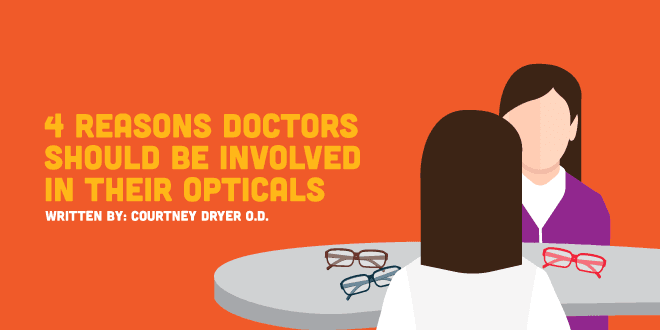As a practitioner, I know if feels you have a million things on your plate from EMRs to ever evolving insurance rules.
We've been told micro-management is a hindrance to our practices; role assignment is key. However, if you are a new grad private practice owner, you must be involved in several aspects of your optical.
Prescribing lens technologies, assessment of insurance reimbursements, inventory management, and lab and product selection are vital to the health and success of your practice.
1. Prescribing Lens Technologies
Doctors should prescribe from the chair.
What does this mean?
The doctor's job is not to just write a prescription, but to identify their patient's needs. Doctors should prescribe from the chair including lens types and lens options.
Be as specific as possible.
It's also important to talk about your practice's products specifically.
Distinguish yourself from other's by communicating with your patients why you have committed to the products you retail in your office.
For example, "You told me that you spend significant time using your computer each day. You also mentioned that you use multiple monitors including a desktop and laptop computer. I recommend an anti-fatigue lens with an anti-reflective coating and transitions lenses. Anti-fatigue lenses make your eyes feel better at the end of the day and will reduce those headaches you mentioned."
2. Assessment of Insurance Reimbursements
How do you do this?
A. A doctor needs to understand their actual profit with each insurance company.
This can be tricky.
Make sure you understand "charge-backs." You must factor in the amount of managed care patients you see during a particular time frame and then determine your operating costs for that time frame. If you make $100 profit after insurance, is it worthwhile to see that patient?
How much are you paying your staff for that same time period? How long does it take for your staff to wrap up a job and file the insurance? Your answers may surprise you.
B. People are human. Even the best ones make mistakes.
It's important to evaluate your practice's billing and recuperation with insurance.
Are co-pays being collected correctly? Are refraction fees being collected on Medicare patients? Are backside UV co-pays being collected with certain types of AR treatments?
These are important things to "spot check" within you practice.
Chargebacks are the amount the insurance decides it costs them to make your patient’s glasses. They deduct this amount from their reimbursement to you.
3. Inventory Management
How much? Of what?
A typical optical has between 500-1000 frames.
This means a significant amount of your cost of goods are frame purchases.
The key is to have adequate choice for patients without excessive money sitting unturned on frame boards. Doctors should know their top sellers.
This is important when you make purchases at Vision Expo Events or when you lose optical staff members. I would advise following the matrix included when stocking your inventory.
See my article on saving money in optical here.
Lastly, organize your optical in a way that your patients are given visual indicators as to a collection's worth. Visual marketing is key to product differentiation.
You should always maintain adequate inventory in your best sellers!
4. Lab and Product Selection
What does this involve?
In another article, I discussed a recent conversation with a lab rep regarding a doctor's potential loss of $80-100 per job when his optician switched labs for promised "kick-backs."
I know most doctors don't enjoy this area of their business, but involvement is vital.
As this industry has changed, profit margins have declined. It's extremely important that doctors maximize their margins. Product selection must be continuously evaluated in terms of quality and cost. One should also take into account their practices percent of progressives vs. single vision jobs.
As always, I advocate for the independent. Look at those labs who are not directly connected to an insurance company. Independent labs are willing to work with you. Support is key from a lab's reps to the staff that answers the phone.
When you are evaluating pricing, make sure you are factoring in extras like edging fees and shipping fees.
